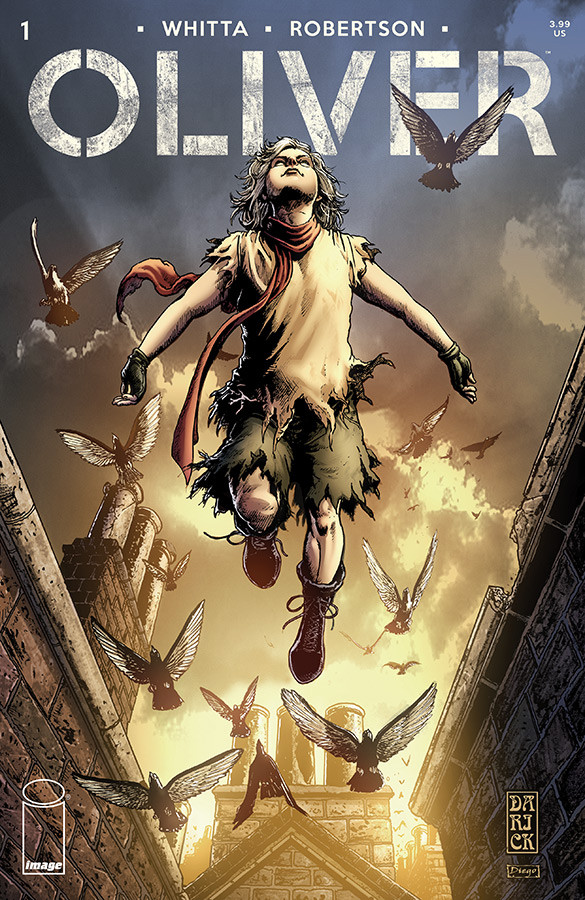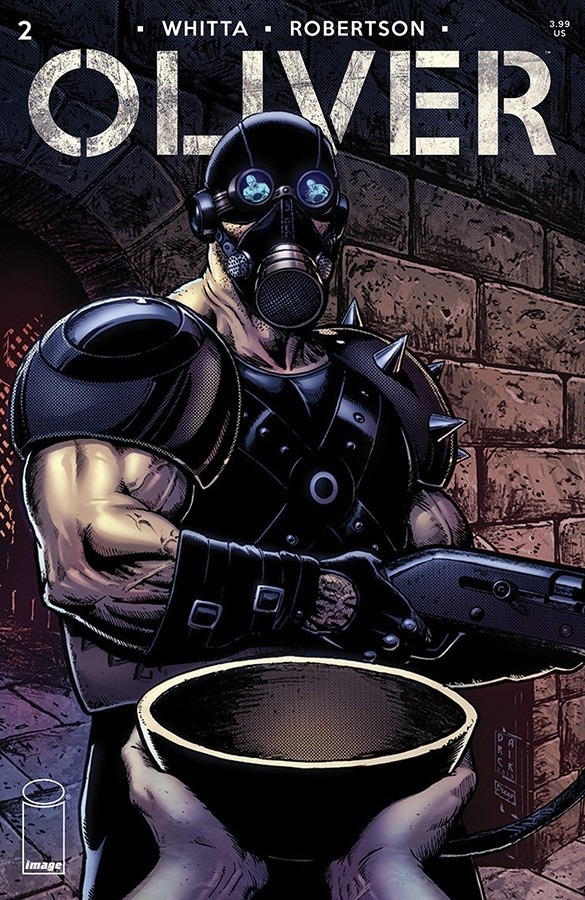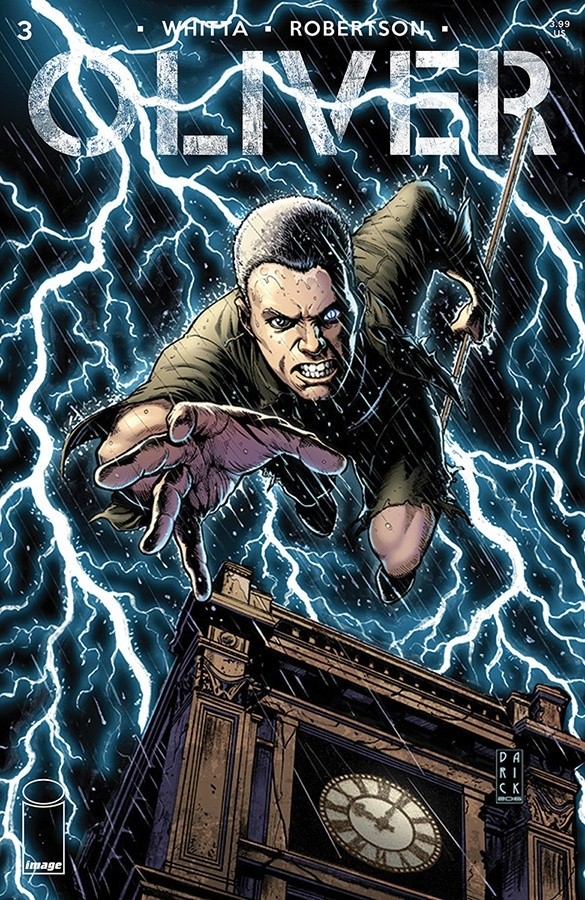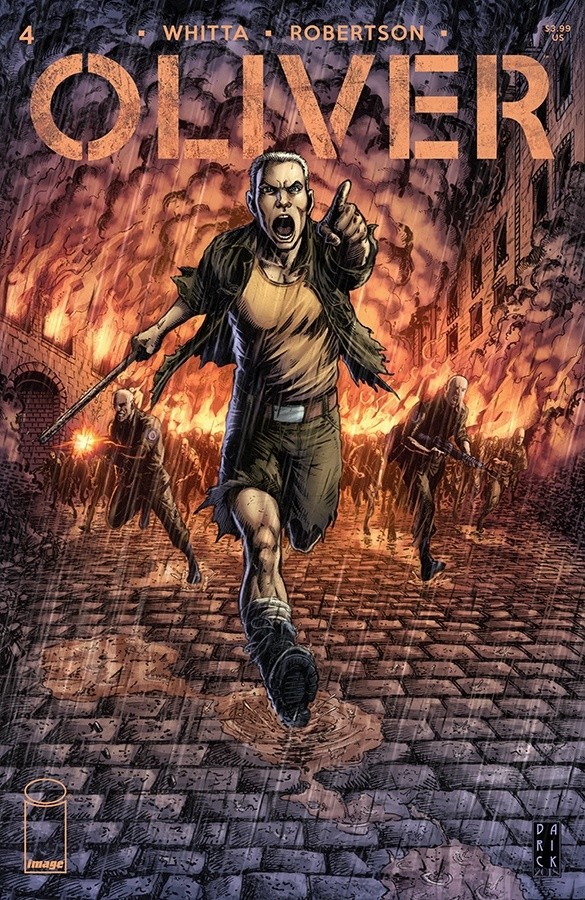Charles Dickens’ novel Oliver Twist has been interpreted and reinterpreted in pop culture, but never quite like what is seen in Image Comics’ Oliver, written by Gary Whitta with Darick Robertson providing gorgeous illustrations for the series. In Oliver, the titular character lives in an irradiated, post-war London, intermingling with and learning from veteran Clone soldiers of a cataclysmic war. In the process, Oliver sees himself finding his own agency and standing up to London’s government forces. It’s a wonderful tale that ruminates on free will and choice, both grand in scope and sometimes small in scale thanks to the phenomenal talents of Whitta and Robertson.
Mr. Robertson spoke with me recently about the conceit of Oliver, the road to making the series a reality, how the book has a superhero aesthetic, and what we can expect to see in the comic moving forward.
FreakSugar: For folks who are considering picking up the book, what is the concept behind Oliver?
Darick Robertson: It’s a reinterpretation of Oliver Twist set in a steampunk inspired post-apocalyptic London.
FS: This is a truly unique concept you’ve come up with. How long has the idea been gestating?
DR: Gary wrote the screenplay some 18 years ago and we decided to create the comic back in 2004, but life, family and for me a few little projects like The Boys and Happy! happened while Gary was creating films like The Book of Eli and Star Wars: Rogue One so while we’ve been great friends and distracted (at least me) we’ve always tried to reconnect and push it forward. We’d get close with some publishers, but ultimately we held out for the kind of offer we got from Image wherein we’d have the freedom to do the book we envisioned and retain rights, control and ownership. So the book has been in construction for a long time, but is everything we hoped it could be, so far.
FS: The collaboration between you two in the first issue is wonderful. How did you two come to work together on this story?
DR: Gary reached out to me while I was living in Brooklyn with my wife and new baby son and while I was buried in deadlines finishing up Transmetropolitan and just beginning a exclusive contract for Marvel to reboot Wolverine with Greg Rucka. Gary had the screenplay written and wanted to work with me based on my Transmet work, but I was too swamped to say yes. I tried to find him and artist and set him up with a publisher because I saw how good the idea was, and in the effort we became friends. A couple of years later it was still up in the air so I agreed to take it on, but the path to this month and it’s release was a long and winding one. Ours is a story of good things coming to those who wait.
FS: In addition to its Dickensian roots, Oliver, while being wholly its own story, seems to share some DNA with other science fiction; The Matrix, The Road, and Kamandi came to mind while reading the first issue. Are there any particular influences that impact how you construct your story?
DR: I’m a fan of all three of those, but ultimately I just wanted to create the world Gary was imagining and bring my own sense of design to it. I brought a sense of steampunk to it as we evolved the idea and that really seems to set it in motion, creatively. What Oliver will be in the second arc is different than who he is in the first four issues, as he evolves as a character, but much the way Batman evolved from young Bruce Wayne and Matt Murdock evolved into Daredevil. Oliver doesn’t put on a costume, but he has a look and presence that he is growing into from issue one through issue four.
FS: Following up on that, what were some beats you wanted to touch on and to stay away from in the sci-fi arena when producing this comic?
DR: When Gary first proposed the idea and then emphasized he saw Oliver as a “superhero” story I started to marry myself to the idea that he needed symbols on his chest and things like that. I dissuaded myself of that notion as we got into creating the art and I am now enmeshing myself in this world and bringing forth his character instead of relying on visual gimmicks to connect to the reader to the character. I am hoping he is interesting and dramatic enough to just be what it says on the cover.
FS: We’re thrust into the world of Oliver after whatever has made London the apocalyptic hellscape we see in the first issue. Do you plan on parsing out hints on how the world came to be in the state that it is?
DR: It’s pretty well explained in the first issue: there was a massive war and they dropped a bomb that irradiated the London air. The world is living in an aftermath of that devastation. Oliver is born into a community of veteran Clone soldiers that were used as human fodder but are human. Even though they look alike, I specifically gave each of our lead clone characters distinguishing wounds so they could be told apart from one another. I also wanted to show that they all had their own story, even though they were meant to be disposable and now are kept under strict control. Oliver is formed as a person of character by living with these disposable humans that have a great sense of loyalty, devotion, duty and honor.
FS: The look of the book is absolutely stunning.
DR: Thank you. That has a lot to do with the incredible color work of my partner in crime Diego Rodriguez and Image Comic’s willingness to give me all the time I literally needed to create something with this level of detail.
FS: How did you decide on what you wanted the aesthetic of the comic to be?
DR: I wanted to bring the cinematic atmosphere Gary intended for the story into being, and at the same time create a comic that I hope readers will enjoy, making an environment you might feel you could explore. Whatever Oliver may become in other media, I always want to have a good comic at its root. I wanted to create a world that is recognizable as London (as I did extensive research to capture London as best I could) and at the same time take the reader away from reality to entertain the idea of this little kid with powers, coming to be, in a hostile world full of threat and danger.
FS: Is there anything you can tease about what we can expect going forward in Oliver?
DR: Yes, the first arc is all about Oliver is coming into being, and the next two arcs will be wherein we’ll meet Dodger and Fagin, and see what Oliver will become. So the first four issues are about establishing who he is, and where he comes from and the latter eight issues are all about who he is and what he will become. It’s a fun hero’s journey and I am excited to get into those arcs as I’m finishing up the first one.
Oliver #4 goes on sale Wednesday, June 26th, from Image Comics.
From the official issue description:
Oliver leads his military family in an uprising against the government forces sent to London to capture him, but at a terrible cost that leaves him grief-stricken—and bent on revenge.




